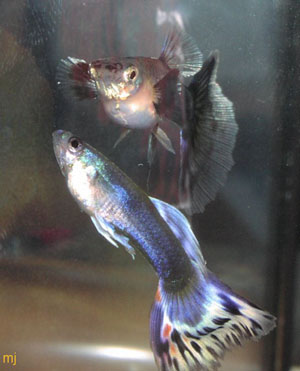
Hospital Tank/Quarantine Tank - essential in fishkeeping.
Whether used only when needed or kept with fish in it that can be removed when necessary, a hospital tank should be available whenever needed to isolate and treat sick fish. This would not include treatment for a problem that is parasitic - at those times it is usually wise to treat the main tank.
Benefits Of Having A Hospital Tank:
- Isolation/quarantine of diseased fish helps protect healthy fish
- Provides safety to ill fish from aggressive fish
- Less medication used in smaller tank gives cost savings
- Hospital tanks can easily be sterilized after use
- More specialized care such as water changes can easily be carried through
- Medications can quickly and easily be removed or changed
- Biological filter in main tank is protected.
You should add an ammonia remover in the filter if you start up the tank only when needed since it is not cycled - Ammo Chips are excellent for this in an inside box filter. Antibiotics will usually destroy the good bacteria in a cycled tank and cause more problems with ammonia. A guppy hospital tank should be around 5 gallons in size, have a clean, bare bottom and be free of any extra decorations that can be stained by medications or carry harmful bacteria with them. A hiding place for the guppy is appreciated and can help in reducing stress. A light is not needed except for inspection - simple daylight suffices.
Use a separate set of equipment, such as nets, siphon, bucket, etc. for the hospital tank. After each use, these should be cleaned with hot water and dried to avoid re-contamination.
Use rubber gloves when changing medicated water. Most chemicals used to treat fish are not completely safe for human contact. Make sure you keep all fish chemicals out of the reach of children!
Proper Treatment
When medicating, it is important to make partial water changes. Change the water in the hospital tank if it has been in use before treatment, and do so as well before each re-treatment, even if it is not specified on the medication's instructions. The reasons for this are: it removes any additional disease-causing organisms in the water; it removes a portion of the medication that has partially or completely decomposed or become deactivated; helps insure against a build-up of toxic substances including ammonia due to biological deterioration (by for instance an antibiotic); and it adds oxygen.
Remove all activated carbon/charcoal from the filter. If the fish show signs of distress in the first 30 to 60 minutes of treatment, remove them immediately to clean, aerated water of the same temperature. Some medications can be too strong for fish that are already ill. Water conditions, such as pH and hardness can affect the toxicity of some chemicals. Most proprietary brands of medications, however, take this into consideration, and this makes them a favourable choice.
When choosing medication, always remember that the narrower the spectrum of a medication, the more potent it usually is. Try to diagnose carefully, and treat only the problem the fish is presently experiencing. Medications that are described as "wide spectrum" or "general" should usually be avoided; do not add anything to a tank that is not particularly needed since the wrong (or additional medication) can weaken the fish so that it will not recover. Research the particular chemical that you are using and follow precautions; for instance, some medication is light sensitive (such as Tetracycline). In this case, keep the lights off and do not allow any sunlight to enter the tank. Some chemicals are reduced by organic matter, pH levels, hard/soft water, etc. If the proper precautions are not taken, you are under dosing the tank and this leads to fish that are not cured, and possibly resistant strains of bacteria.
Use medication only when really needed. Using them as a precaution is not a good idea. Always strive for prevention in a natural way - proper care with sufficient water changes and definitely no overfeeding, and you will find yourself needing very little fish medication. Admittedly, while often the diagnosis of fish diseases/parasites may be only an educated guess, one should try to use no more chemicals than is deemed necessary for a cure. Fish medications are strong chemicals for fish to endure, especially when they are already weakened by sickness. Understand just what the chemicals treat, and the specific chemical's drawbacks.
It is also important to remember that medication needs to be given a chance to work; also that there is a possibility that it is the wrong medication and you should keep a close eye on the patient. You should see improvement within a week of starting medication. Three full treatments of most medication (follow instructions as shown on the remedy) should be given (as well as 3 partial water changes), and if there is any improvement, proceed until finished.
If there is no sign of improvement or if the fish's condition seems to be worsening, try changing treatment. In order to do this, however, the old medication needs to be removed. The safest way to remove copper and other chemicals is to make water changes in addition to carbon filtration for 12 hours.